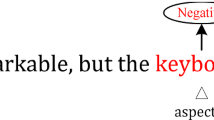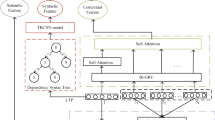Abstract
Target-specific sentiment classification has a dependency over the target term extraction. The majority of current studies in sentiment classification tasks do not utilize the complete linguistic and sentiment knowledge. Consequently, strenuous efforts are to be made for expressing the implications of each word from the sentences, which have significant amount of contextual dependencies. Hence, it leads to the problems like loss of semantics, missing of context-dependent information and also results in poor classification of the models. In this paper, we propose a Deep Finesse Network (DFN) to address these limitations and enhance the accuracy. The DFN employs a multichannel paradigm to exploit multi-grained sentiment features by leveraging the existing linguistic and sentiment knowledge more effectively without any human involvement. In each channel, the model firstly extracts the local features from the multi-grained sentiment features and then captures the global and spatial information of the identified local features. Secondly, it directly models the contextual relationships with enriched semantic information from the global features. Subsequently, the intra-sequence relations were also modeled among the contextual features to identify the target features in order to understand and predict the sentiments of identified contextual features. Finally, the effectiveness of the DFN is also evaluated on different datasets. The results proved that DFN outperforms all the current and advanced state-of-art models in classification accuracy in most cases.








Similar content being viewed by others
References
Chaturvedi I, Ragusa E, Gastaldo P, Zunino R, Cambria E (2018) Bayesian network based extreme learning machine for subjectivity detection. J Frankl Inst 355:1780–1797. https://doi.org/10.1016/j.jfranklin.2017.06.007
Poria S, Hussain A, Cambria E (2018) Sentic Patterns: Sentiment Data Flow Analysis by Means of Dynamic Linguistic Patterns. In: Sentic patterns: sentiment data flow analysis by means of dynamic linguistic patterns, in. https://doi.org/10.1007/978-3-319-95020-4_6
Wiebe J, Wilson T, Cardie C (2005) Annotating expressions of opinions and emotions in language. Lang. Resour. Eval. https://doi.org/10.1007/s10579-005-7880-9
Ruppenhofer J, Somasundaran S, Wiebe J (2008) Finding the sources and targets of subjective expressions, in: Proc. 6th Int. Conf. Lang. Resour. Eval. Lr. 2008
Dragoni M, Tettamanzi AGB, da Costa Pereira C (2014) A fuzzy system for concept-level sentiment analysis. Commun. Comput. Inf. Sci. https://doi.org/10.1007/978-3-319-12024-9_2
Do HH, Prasad PWC, Maag A, Alsadoon A (2019) Deep learning for aspect-based sentiment analysis: a comparative review. Expert Syst Appl 118:272–299. https://doi.org/10.1016/j.eswa.2018.10.003
Cambria E (2016) Affective computing and sentiment analysis. IEEE Intell Syst 31:102–107. https://doi.org/10.1109/MIS.2016.31
Salas-Zárate MP, Medina-Moreira J, Lagos-Ortiz K, Luna-Aveiga H, Rodríguez-García MÁ, Valencia-García R (2017) Sentiment Analysis on Tweets about Diabetes: An Aspect-Level Approach. Comput. Math. Methods Med 2017:1–9. https://doi.org/10.1155/2017/5140631
Berka P (2020) Sentiment analysis using rule-based and case-based reasoning, 51–66
Giannakopoulos A, Musat C, Hossmann A, Baeriswyl M (2018) Unsupervised Aspect Term Extraction with B-LSTM and CRF using Automatically Labelled Datasets, in: 2018. https://doi.org/10.18653/v1/w17-5224
Zhang B, Xu X, Li X, Chen X, Ye Y, Wang Z (2019) Sentiment analysis through critic learning for optimizing convolutional neural networks with rules. Neurocomputing. 356:21–30. https://doi.org/10.1016/j.neucom.2019.04.038
Yousif A, Niu Z, Chambua J, Khan ZY (2019)Multi-task learning model based on recurrent convolutional neural networks for citation sentiment and purpose classification. Neurocomputing. 335:195–205. https://doi.org/10.1016/j.neucom.2019.01.021
Akhtar MS, Garg T, Ekbal A (2020)Multi-task learning for aspect term extraction and aspect sentiment classification. Neurocomputing. 398:247–256. https://doi.org/10.1016/j.neucom.2020.02.093
Ren L, Xu B, Lin H, Liu X, Yang L (2020) Sarcasm detection with sentiment semantics enhanced multi-level memory network. Neurocomputing. 401:320–326. https://doi.org/10.1016/j.neucom.2020.03.081
Jain DK, Jain R, Upadhyay Y, Kathuria A, Lan X (2020) Deep refinement: capsule network with attention mechanism-based system for text classification. Neural Comput Appl 32:1839–1856. https://doi.org/10.1007/s00521-019-04620-z
Yadav A, Vishwakarma DK (2020) Sentiment analysis using deep learning architectures: a review. Artif. Intell. Rev. https://doi.org/10.1007/s10462-019-09794-5
Kulkarni A, Shivananda A, Kulkarni A, Shivananda A (2019) Deep learning for NLP, in: Nat. Lang. Process. Recipes, https://doi.org/10.1007/978-1-4842-4267-4_6
Ghorbani M, Bahaghighat M, Xin Q, Özen F (2020) ConvLSTMConv network: a deep learning approach for sentiment analysis in cloud computing. J Cloud Comput 9:1–12. https://doi.org/10.1186/s13677-020-00162-1
Kim J, Jang S, Park E, Choi S (2020) Text classification using capsules. Neurocomputing. https://doi.org/10.1016/j.neucom.2019.10.033
Tang D, Qin B, Feng X, Liu T (2016) Effective LSTMs for target-dependent sentiment classification, COLING 2016 - 26th Int. Conf. Comput. Linguist. Proc. COLING 2016 Tech. Pap. 3298–3307
Wang Y, Huang M, Zhao L, Zhu X (2016)Attention-based LSTM for aspect-level sentiment classification, EMNLP 2016 - Conf. Empir. Methods Nat. Lang. Process. Proc. 606–615. https://doi.org/10.18653/v1/d16-1058
Nguyen HT, Le Nguyen M (2018) Effective Attention Networks for Aspect-level Sentiment Classification. Proc. 2018 10th Int. Conf. Knowl. Syst. Eng. KSE 2018:25–30. https://doi.org/10.1109/KSE.2018.8573324
Li X, Bing L, Lam W, Shi B (2018) Transformation networks for target-oriented sentiment classification, in: ACL 2018 - 56th Annu. Meet. Assoc. Comput. Linguist. Proc. Conf. (Long Pap., https://doi.org/10.18653/v1/p18-1087
Liu N, Shen B (2020) ReMemNN: a novel memory neural network for powerful interaction in aspect-based sentiment analysis. Neurocomputing. 395:66–77. https://doi.org/10.1016/j.neucom.2020.02.018
Liu B (2015) Sentiment analysis: mining opinions, sentiments, and emotions. https://doi.org/10.1017/CBO9781139084789
Wei J, Liao J, Yang Z, Wang S, Zhao Q (2020)Bi-LSTM with multi-polarity orthogonal attention for implicit sentiment analysis. Neurocomputing. 383:165–173. https://doi.org/10.1016/j.neucom.2019.11.054
Tan X, Cai Y, Xu J, Leung HF, Chen W, Li Q (2020) Improving aspect-based sentiment analysis via aligning aspect embedding. Neurocomputing. 383:336–347. https://doi.org/10.1016/j.neucom.2019.12.035
Liu F, Zheng L, Zheng J (2020) HieNN-DWE: a hierarchical neural network with dynamic word embeddings for document level sentiment classification. Neurocomputing. 403:21–32. https://doi.org/10.1016/j.neucom.2020.04.084
Liu F, Zheng J, Zheng L, Chen C (2020) Combining attention-based bidirectional gated recurrent neural network and two-dimensional convolutional neural network for document-level sentiment classification. Neurocomputing. 371:39–50. https://doi.org/10.1016/j.neucom.2019.09.012
Chen F, Huang Y (2019)Knowledge-enhanced neural networks for sentiment analysis of Chinese reviews. Neurocomputing. 368:51–58. https://doi.org/10.1016/j.neucom.2019.08.054
Tang D, Qin B, Feng X, Liu T (2015)Target-Dependent Sentiment Classification with Long Short Term Memory, ArXiv Prepr. ArXiv1512.01100
Penghua Z, Dingyi Z (2019)Bidirectional-GRU based on attention mechanism for aspect-level sentiment analysis, in: ACM Int. Conf. Proceeding Ser. https://doi.org/10.1145/3318299.3318368
Yang C, Zhang H, Jiang B, Li K (2019)Aspect-based sentiment analysis with alternating coattention networks. Inf Process Manag 56:463–478. https://doi.org/10.1016/j.ipm.2018.12.004
Fan F, Feng Y, Zhao D (2020)Multi-grained attention network for aspect-level sentiment classification. Proc. 2018 Conf. Empir. Methods Nat. Lang. Process. EMNLP 2018:3433–3442. https://doi.org/10.18653/v1/d18-1380
Zhou J, Chen Q, Huang JX, Hu QV, He L (2020)Position-aware hierarchical transfer model for aspect-level sentiment classification. Inf. Sci. (Ny) 513:1–16. https://doi.org/10.1016/j.ins.2019.11.048
Park HJ, Song M, Shin KS (2020) Deep learning models and datasets for aspect term sentiment classification: Implementing holistic recurrent attention on target-dependent memories. Knowledge-Based Syst 187:104825. https://doi.org/10.1016/j.knosys.2019.06.033
Ma X, Zeng J, Peng L, Fortino G, Zhang Y (2019) Modeling multi-aspects within one opinionated sentence simultaneously for aspect-level sentiment analysis. Futur Gener Comput Syst 93:304–311. https://doi.org/10.1016/j.future.2018.10.041
Hazarika D, Poria S, Vij P, Krishnamurthy G, Cambria E, Zimmermann R (2018) Modeling inter-aspect dependencies for aspect-based sentiment analysis, NAACL HLT 2018–2018 Conf. North Am. Chapter Assoc. Comput. Linguist. Hum. Lang. Technol. - Proc. Conf. 2 266–270. https://doi.org/10.18653/v1/n18-2043
Song Y, Wang J, Jiang T, Liu Z, Rao Y (2019) Targeted Sentiment Classification with Attentional Encoder Network, Lect. Notes Comput. Sci. (Including Subser. Lect. Notes Artif. Intell. Lect. Notes Bioinformatics). 11730 LNCS 93–103. https://doi.org/10.1007/978-3-030-30490-4_9
Chen P, Sun Z, Bing L, Yang W (2017) Recurrent attention network on memory for aspect sentiment analysis. EMNLP 2017 - Conf. Empir. Methods Nat. Lang. Process. Proc:452–461. https://doi.org/10.18653/v1/d17-1047
Su J, Yu S, Luo D (2020) Enhancing aspect-based sentiment analysis with capsule network. IEEE Access 8:100551–100561. https://doi.org/10.1109/ACCESS.2020.2997675
Xu Q, Zhu L, Dai T, Yan C (2020)Aspect-based sentiment classification with multi-attention network. Neurocomputing. 388:135–143. https://doi.org/10.1016/j.neucom.2020.01.024
Gu S, Zhang L, Hou Y, Song Y (2018) A position-aware bidirectional attention network for aspect-level sentiment analysis, Proc. 27th Int. Conf. Comput. Linguist. 774–784. http://www.aclweb.org/anthology/C18-1066
Zhao P, Hou L, Wu O (2020) Modeling sentiment dependencies with graph convolutional networks for aspect-level sentiment classification. Knowledge-Based Syst 193. https://doi.org/10.1016/j.knosys.2019.105443
Wagner J, Arora P, Cortes S, Barman U, Bogdanova D, Foster J, Tounsi L (2015) DCU: Aspect-based Polarity Classification for SemEval Task 4:223–229. https://doi.org/10.3115/v1/s14-2036
Xue W, Li T (2018) Aspect based sentiment analysis with gated convolutional networks, ACL 2018 - 56th Annu. Meet. Assoc. Comput. Linguist. Proc. Conf. (Long Pap. 1 2514–2523. https://doi.org/10.18653/v1/p18-1234
Shuang K, Ren X, Yang Q, Li R, Loo J (2019) AELA-DLSTMs: attention-enabled and location-aware double LSTMs for aspect-level sentiment classification. Neurocomputing. 334:25–34. https://doi.org/10.1016/j.neucom.2018.11.084
Mihalcea R, Tarau P (2004) TextRank: bringing order into texts. Proc. EMNLP. https://doi.org/10.3115/1219044.1219064
Mihalcea R (2004)Graph-based ranking algorithms for sentence extraction, applied to text summarization, in: https://doi.org/10.3115/1219044.1219064
Yang K, Chen Z, Cai Y, Huang DP, Leung HF, Improved automatic keyword extraction given more semantic knowledge, in: Lect. Notes Comput. Sci. (Including Subser. Lect. Notes Artif. Intell. Lect. Notes Bioinformatics), 2016. https://doi.org/10.1007/978-3-319-32055-7_10
Wen Y, Yuan H, Zhang P, Research on keyword extraction based on Word2Vec weighted TextRank, in: 2016 2nd IEEE Int. Conf. Comput. Commun. ICCC 2016 - Proc., 2017. https://doi.org/10.1109/CompComm.2016.7925072
C. Mallick, A.K. Das, M. Dutta, A.K. Das, A. Sarkar (2018)Graph-based text summarization using modified TextRank, in: Adv. Intell. Syst. Comput., https://doi.org/10.1007/978-981-13-0514-6_14
Alfred R, Mujat A, Obit JH, A Ruled-Based Part of Speech (RPOS) tagger for Malay text articles, in: Lect. Notes Comput. Sci. (Including Subser. Lect. Notes Artif. Intell. Lect. Notes Bioinformatics), 2013: pp. 50–59. https://doi.org/10.1007/978-3-642-36543-0_6
Hutto CJ, Gilbert E, VADER: A parsimonious rule-based model for sentiment analysis of social media text, in: Proc. 8th Int. Conf. Weblogs Soc. Media, ICWSM 2014, 2014
Yang M, Zhao W, Chen L, Qu Q, Zhao Z, Shen Y (2019) Investigating the transferring capability of capsule networks for text classification. Neural Netw 118:247–261. https://doi.org/10.1016/j.neunet.2019.06.014
Saif H, He Y, Fernandez M, Alani H (2016) Contextual semantics for sentiment analysis of twitter. Inf Process Manag 52:5–19. https://doi.org/10.1016/j.ipm.2015.01.005
Letarte G, Paradis F, Giguère P, Laviolette F, Importance of Self-Attention for Sentiment Analysis, in: 2019. https://doi.org/10.18653/v1/w18-5429
Ambartsoumian A, Popowich F, Self-Attention: A Better Building Block for Sentiment Analysis Neural Network Classifiers, in: 2019. https://doi.org/10.18653/v1/w18-6219
Akhtar MS, Kumar A, Ghosal D, Ekbal A, Bhattacharyya P, A Multilayer perceptron based ensemble technique for fine-grained financial sentiment analysis, in: EMNLP 2017 - Conf. Empir. Methods Nat. Lang. Process. Proc., 2017. https://doi.org/10.18653/v1/d17-1057
Al-Batah MS, Mrayyen S, Alzaqebah M (2018) Investigation of naive Bayes combined with multilayer perceptron for Arabic sentiment analysis and opinion mining. J. Comput. Sci. https://doi.org/10.3844/jcssp.2018.1104.1114
Nwankpa C, Ijomah W, Gachagan A, Marshall S, Activation Functions: Comparison of trends in Practice and Research for Deep Learning, (2018) 1–20. http://arxiv.org/abs/1811.03378
Tao J, Fang X (2020) Toward multi-label sentiment analysis: a transfer learning based approach. J Big Data 7:1–26. https://doi.org/10.1186/s40537-019-0278-0
Hancock JT, Khoshgoftaar TM (2020) Survey on categorical data for neural networks. J. Big Data 7. https://doi.org/10.1186/s40537-020-00305-w
Wang B, Wang A, Chen F, Wang Y, Kuo CCJ (2019) Evaluating word embedding models: methods and experimental results. APSIPA Trans Signal Inf Process 8:1–13. https://doi.org/10.1017/ATSIP.2019.12
Pennington J, Socher R, Manning CD, GloVe: Global vectors for word representation, in: EMNLP 2014–2014 Conf. Empir. Methods Nat. Lang. Process. Proc. Conf., 2014. https://doi.org/10.3115/v1/d14-1162
Joulin A, Grave E, Bojanowski P, Mikolov T, Bag of tricks for efficient text classification, in: 15th Conf. Eur. Chapter Assoc. Comput. Linguist. EACL 2017 - Proc. Conf., 2017. https://doi.org/10.18653/v1/e17-2068
Howard J, Ruder S Universal language model fine-tuning for text classification, in: ACL 2018 - 56th Annu. Meet. Assoc. Comput. Linguist. Proc. Conf. (Long Pap., 2018. https://doi.org/10.18653/v1/p18-1031
Author information
Authors and Affiliations
Corresponding author
Ethics declarations
Conflict of interest
The authors declare that they have no known competing financial interests or personal relationships that could have appeared to influence the work reported in this paper.
Additional information
Publisher’s note
Springer Nature remains neutral with regard to jurisdictional claims in published maps and institutional affiliations.
Rights and permissions
About this article
Cite this article
Edara, D.C., Sistla, V. & Kolli, V.K.K. Deep finesse network model with multichannel syntactic and contextual features for target-specific sentiment classification. Appl Intell 52, 8664–8684 (2022). https://doi.org/10.1007/s10489-021-02692-w
Accepted:
Published:
Issue Date:
DOI: https://doi.org/10.1007/s10489-021-02692-w




